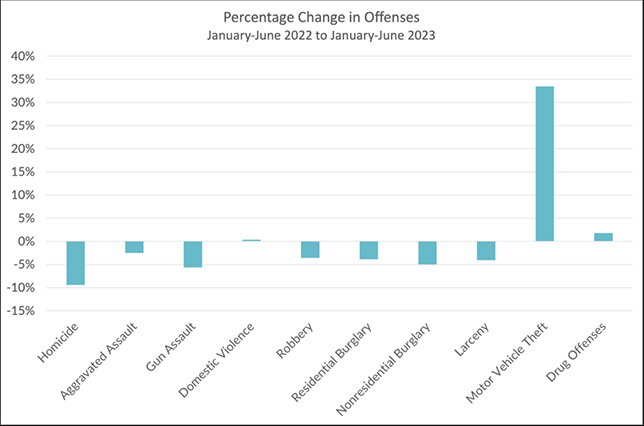Recently, Contra Costa County has been experiencing a rash of car thefts. Unfortunately, this is a national trend, and the Council on Criminal Justice reports that there were 33.5% more motor vehicle thefts in the first half of 2023 compared to the first half of 2022.
The California Highway Patrol has these tips to help you avoid thefts:
Always:
- Always lock your vehicle.
- Always utilize anti-theft devices.
- Always park your vehicle in a well-lighted area at night.
- Always make sure you receive an ownership certificate when purchasing a used vehicle.
Never:
- Never leave your keys in your vehicle.
- Never hide a spare ignition key on the vehicle.
More theft protection tips:
- Install an audible alarm system.
- When possible, park your vehicle in a secure garage.
- Beware of your surroundings prior to leaving your vehicle.
- Access the National Motor Vehicle Title Information System at vehiclehistory.gov or through a third party like CarFax to check a car’s VIN before you purchase it. Learn more about NMVTIS with these videos in English and Spanish.

Imagine by Council on Criminal Justice
Homicide, Other Violent Crimes Decline in U.S. Cities but Remain Above Pre-Pandemic Levels
- This study updates and supplements previous U.S. crime trends reports by the Council on Criminal Justice (CCJ) with additional crime data through June 2023. It examines monthly crime rates for 10 violent, property, and drug offenses in 37 American cities. The 37 cities are not necessarily representative of all cities in the United States. Not all cities reported data for each offense (see Appendix), and the data used to measure the crime trends are subject to revision by local jurisdictions.
- This snapshot suggests that levels of nearly all offenses are lower, or have changed little, in the first six months of 2023 compared with the same period in 2022. The most notable exception is the large increase in motor vehicle theft.
- The number of homicides in the 30 study cities providing homicide data was 9.4% lower—202 fewer homicides—during the first half of 2023 than in the first half of 2022.
- There were 2.5% fewer aggravated assaults in the first half of 2023 compared to the first half of 2022. The number of gun assaults also dropped (-5.6%) over the same period, but this trend is based on data from just 10 cities and should be viewed with caution.
- Robberies, residential burglaries, nonresidential burglaries, and larcenies all decreased in the first half of 2023 compared to the first half of 2022. Robberies fell by 3.6%, residential burglaries by 3.8%, nonresidential burglaries by 5%, and larcenies by 4.1%.
- Motor vehicle thefts continued their upward trend through the first half of 2023. There were 33.5% more motor vehicle thefts from January through June 2023 compared to the first half of 2022. The number of drug offenses increased by 1% over the same period.
- Domestic violence incidents increased by 0.3% in 11 cities during the first half of 2023 compared to the first half of 2022.
- Violent crimes remain elevated compared to 2019, the year prior to the COVID pandemic and racial justice protests of 2020. There were 24% more homicides during the first half of 2023 than during the first half of 2019 in the study cities. Property crime trends have been more mixed. There were fewer residential burglaries and larcenies and more nonresidential burglaries in the first half of 2023 than during the same period four years earlier. Motor vehicle thefts more than doubled (+104%), while drug offenses fell by 39%.
- The authors conclude that crime patterns continue to shift as the nation has emerged from the COVID pandemic and that policymakers and communities must act urgently to adapt their strategies to meet the new challenges. Though the level of serious violent crime is far below historical peaks, it remains intolerably high, especially in poorer communities of color. Research has identified strategies that work to reduce violence and improve the fairness and effectiveness of policing. Intensive efforts on both fronts are essential to help cities achieve lasting reductions in homicide and other crime.
Washington, DC – Homicide and most other violent crimes declined in American cities in the first half of 2023, but they remain above levels seen before the onset of the coronavirus pandemic and nationwide protests that followed the killing of George Floyd, according to a new study of crime trends in 37 cities released today by the Council on Criminal Justice.
Examining homicides in 30 cities that make homicide data readily available, the analysis found that the number of murders in the first half of 2023 fell by 9.4% compared to the first half of 2022 (a decrease of 202 homicides in those cities). Twenty of the study cities recorded a decrease in homicides during the first six months of the year, ranging from a 59% drop in Raleigh, NC, to a 2% drop in Nashville, TN. Ten cities experienced an increase in homicide, ranging from about 5% in Seattle to 133% in Lincoln, NE.
Motor vehicle thefts, which began to rise at the onset of the pandemic, continued an upward trend. Considered a “keystone crime” that facilitates the commission of homicide and other offenses, motor vehicle theft rose by 33.5% in the first half of the year, representing 23,974 more stolen vehicles in the 32 cities that reported data. Seven of those cities experienced an increase of 100% or more, led by Rochester, NY, (+355%) and Cincinnati (+162%). Overall, the number of vehicle thefts from January to June 2023 was 104.3% higher than during the same period in 2019. While it’s likely that much of the increase is the result of thefts of Kia and Hyundai models, the authors said, rates were rising before the cars became popular targets.
In other findings, gun assaults (-5.6%), robberies (-3.6%), nonresidential burglaries (-5%), larcenies (-4.1%), residential burglaries (-3.8%), and aggravated assaults (-2.5%) all fell in the first six months of this year compared to the same timeframe last year. Drug offenses rose by 1% and domestic violence by 0.3%.
“The decline we see across the major crime categories is encouraging, but our country should not be comfortable with rates of violence that continue to claim thousands of lives each year,” said University of Missouri – St. Louis Professor Emeritus Richard Rosenfeld, co-author of the study and chair of CCJ’s recently formed Crime Trends Working Group. “We now have a solid array of research-backed crime prevention tools at our disposal. Law enforcement, policymakers, and communities should redouble efforts to deploy them.”
Expanding on the analysis of mid-year 2023 trends, the study provides comparisons with offense levels recorded in 2019, before the coronavirus, the killing of Floyd, and the ensuing mass protests over police violence. Violent crimes remained higher during the first half of 2023 compared to the first half of 2019. While homicide has receded from its peak in 2021, levels remained 24% higher than in the first half of 2019. Even if homicide rates were to fall back to pre-pandemic levels, the 2019 homicide rate was still 15% higher than in 2014, the lowest level recorded since World War II. Gun assaults (+39%), aggravated assaults (+8%), and robberies (+2%) also remained higher in the first half of 2023 compared to the first half of 2019.
Property crime trends were more mixed as motor vehicle thefts (+104.3%) and nonresidential burglaries (+5.1%) were higher in the first half of 2023 compared to the same period in 2019, while drug offenses (-38.7%), residential burglaries (-26%), and larcenies (-7%) were lower.
“The downward trends in violent crime we’re seeing as the pandemic recedes should not dim the intensity of our commitment to reduce violence across the country,” said CCJ Research Specialist Ernesto Lopez, the study’s co-author. “Although the levels of homicide and other violent crime are well below historical peaks, they remain intolerably high, especially in poorer communities of color.”
The authors noted that CCJ’s Task Force on Policing and Violent Crime Working Group highlight numerous reforms to improve policing and strengthen the overall effectiveness of violence reduction efforts in the U.S. In addition, the Crime Trends Working Group is currently investigating trends for multiple offenses and exploring ways to improve the nation’s crime data infrastructure.
Support for the group and the mid-year 2023 crime analysis comes from the Annie E. Casey Foundation, Arnold Ventures, the Harry Frank Guggenheim Foundation, Southern Company Foundation, and Stand Together Trust, as well as #StartSmall, the John D. and Catherine T. MacArthur Foundation and other CCJ general operating contributors.
About the Report and Data
Co-authored by Rosenfeld, Lopez, and Doctoral Candidate Bobby Boxerman, the new analysis updates a series of earlier reports with new data through June 2023. It examined crime rates for 10 violent, property, and drug offenses in 37 U.S. cities, including Atlanta, Detroit, Phoenix, Chicago, Denver, Memphis, San Francisco, Los Angeles, Washington, D.C., and Philadelphia. The smallest city in the sample was Chattanooga, TN, with 179,690 residents; the largest was New York, with more than 8.4 million residents. The 37 cities are not necessarily representative of all cities in the U.S., and not all cities reported data for each offense.
The data for this report were obtained within days of the end of the study period in order to provide a timely snapshot of crime across the nation. As a result, these figures may and likely will differ from data subsequently published by individual police departments. For the most up-to-date information for a specific city, please visit its website.
About the Council on Criminal Justice
The Council on Criminal Justice (CCJ) is a nonpartisan invitational membership organization and think tank that advances understanding of the criminal justice policy challenges facing the nation and builds consensus for solutions based on facts, evidence, and fundamental principles of justice.
Editors note:
- Aug 14 – Antioch Hit with 328 Vehicle Thefts Since May 28
- April 20 – AG Bonta Leads States Calling for Recall of Theft-Prone Hyundai and Kia Vehicles


1 comment
Here’s a tip…
1) Support law enforcement
2) Prosecute criminals
3) Hire more cops
Its not that hard to solve the puzzle.
Comments are closed.